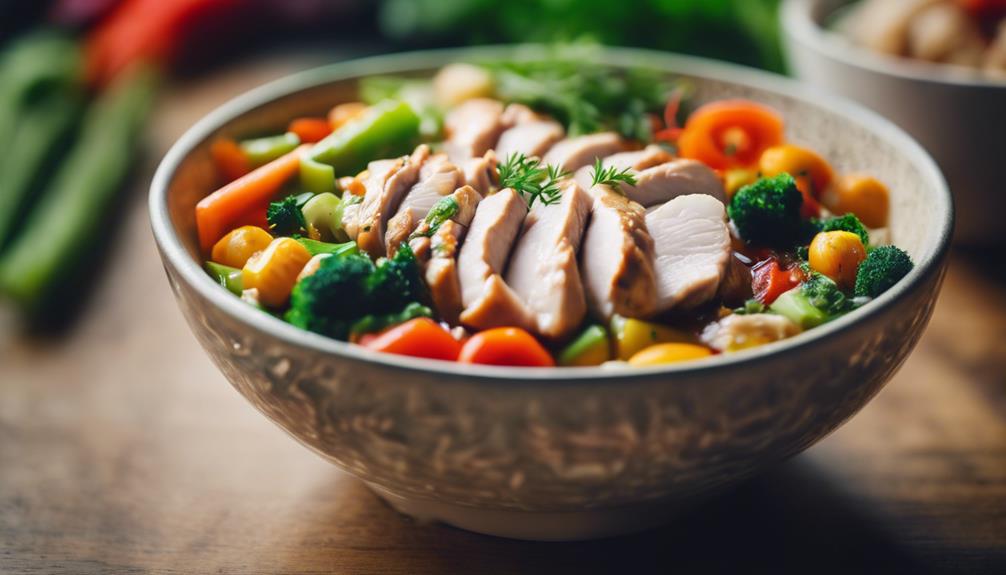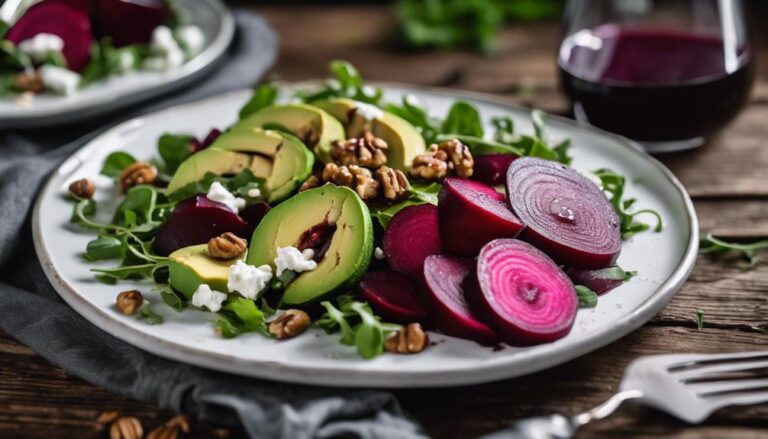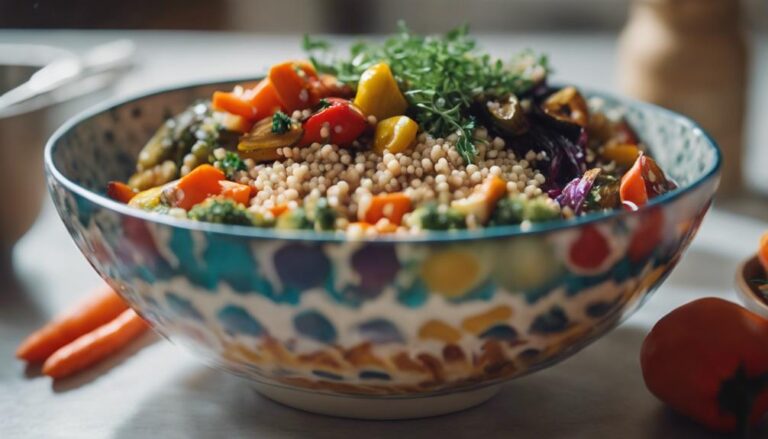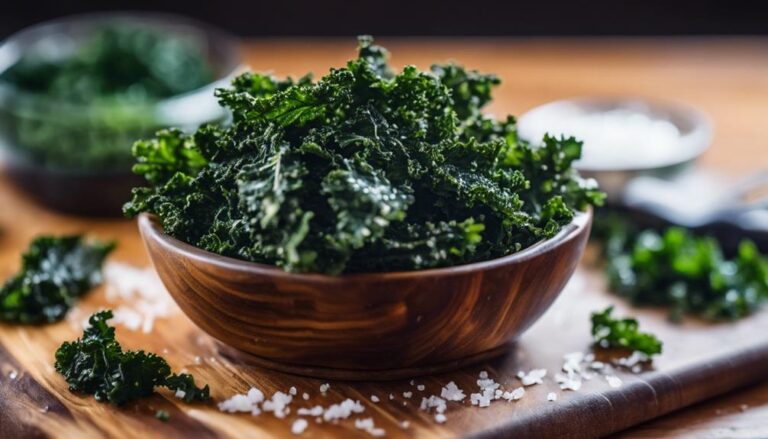Soup Sous Vide Chicken and Vegetable Soup for the 80/20 Diet
Elevate your 80/20 diet with a flavorful twist using soup sous vide. Precisely infusing chicken and seasonal vegetables brings both taste and nutrition to your table. Benefit from locked-in flavors, even cooking, and consistent delicious results. Choose quality ingredients like rich broths and fresh vegetables. Try savory recipes like Chicken Noodle or Lentil Vegetable Soup. Experiment with herb and spice infusions for dynamic flavors. Consider balanced textures and health benefits. Perfect for meal prep and freezing for quick, nutritious meals. Enhance your dining experience with a fusion of taste and health benefits.
What You Will Learn Here
- Balanced mix of chicken and vegetables for nutrient-rich meal.
- Fits 80/20 diet with emphasis on wholesome ingredients.
- Sous vide technique preserves flavors and juiciness.
- Convenient meal prep and storage for busy lifestyles.
- Offers a delicious and healthy soup option.
Soup-Making Evolution
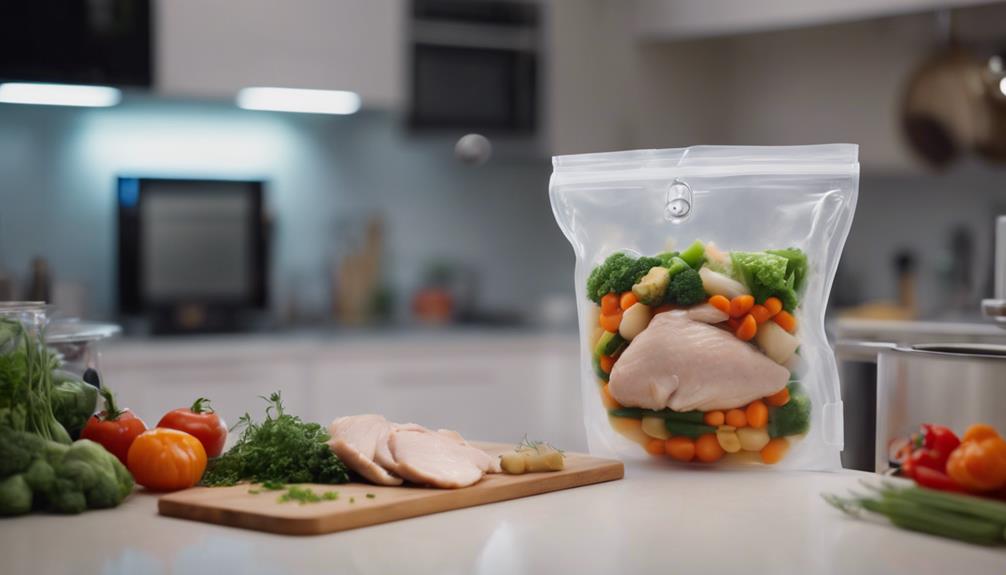
When it comes to soup-making evolution, there are key aspects to take into account:
- soup-making techniques
- flavor infusion tips
- ingredient pairing secrets
Understanding these elements can elevate your soup game and help you create delicious, well-balanced soups every time.
Soup-Making Techniques
As you explore the evolution of soup-making techniques, you'll discover a rich history of culinary experimentation. Traditionally, soup preparation involved long hours of broth simmering over a gentle heat. This slow process allowed flavors to meld and intensify, creating a rich base for the soup.
Ingredient blending was done by hand, with chefs meticulously chopping and mixing to achieve the desired consistency and taste.
—
Over time, advancements in kitchen technology revolutionized soup-making techniques. Blenders and food processors made ingredient blending a quick and efficient task, resulting in smoother and more consistent soups. The introduction of pressure cookers and slow cookers also brought about changes in how broths were simmered, reducing cooking times without compromising flavor.
—
Today, with the advent of sous vide cooking, soup-making has reached new levels of precision and control. This method involves vacuum-sealing ingredients in a bag and cooking them in a precisely controlled water bath for excellent flavor infusion. These modern techniques have made creating delicious and nutritious soups more accessible and convenient for home cooks and professional chefs alike.
Flavor Infusion Tips
Enhance your soup's flavor profile through strategic ingredient pairings and infusion techniques. When it comes to creating a delicious soup, understanding sous vide secrets and infusion techniques can take your culinary skills to the next level.
Flavor pairing is essential in soup-making, as certain ingredients complement each other harmoniously. For example, combining garlic and thyme can add depth and a savory undertone to your soup, while a hint of lemon zest brightens the overall flavor.
Ingredient infusion is another key aspect worth exploring. By slowly infusing flavors from herbs, spices, or aromatics into your soup base using sous vide methods, you allow the ingredients to meld together seamlessly, resulting in a robust and well-rounded taste.
Experiment with different infusion techniques such as simmering ingredients on low heat for an extended period or utilizing a sous vide machine to achieve precise and consistent flavor infusion.
Ingredient Pairing Secrets
Explore the evolution of soup-making through the secrets of ingredient pairing for a transformative culinary experience. The art of ingredient pairing is essential in creating delicious soups that tantalize the taste buds. By combining flavors thoughtfully, you can elevate your soup to new heights.
Consider the dynamic duo of sweet carrots and earthy cumin, or the classic combination of tomatoes and basil for a burst of freshness. These flavor combinations can add depth and complexity to your soups, making each spoonful a delightful journey for the palate.
In the modern twists of soup evolution, don't be afraid to experiment with unexpected pairings. Try adding a hint of ginger to your butternut squash soup or a dash of coconut milk to your chicken broth for a unique twist. The key to successful ingredient pairing lies in balancing complementary flavors to create a harmonious blend.
Key Soup Components
Include essential ingredients like chicken, vegetables, and broth to create the foundation of your delicious soup.
When it comes to crafting a flavorful and nutritious soup, focusing on quality soup components is crucial. Here are three key components you should pay attention to:
- Chicken: Opt for high-quality chicken sourced from a reputable supplier to guarantee your soup is packed with flavor and essential proteins.
- Vegetables: Fresh and seasonal vegetables not only add color and texture but also provide a range of vitamins and minerals. Consider sourcing your vegetables from local farmers' markets for the freshest options.
- Broth: The base of your soup, the broth, can make or break the dish. Choose a rich and flavorful broth, whether store-bought or homemade, to enhance the overall taste of your soup.
Top Soup Recipes
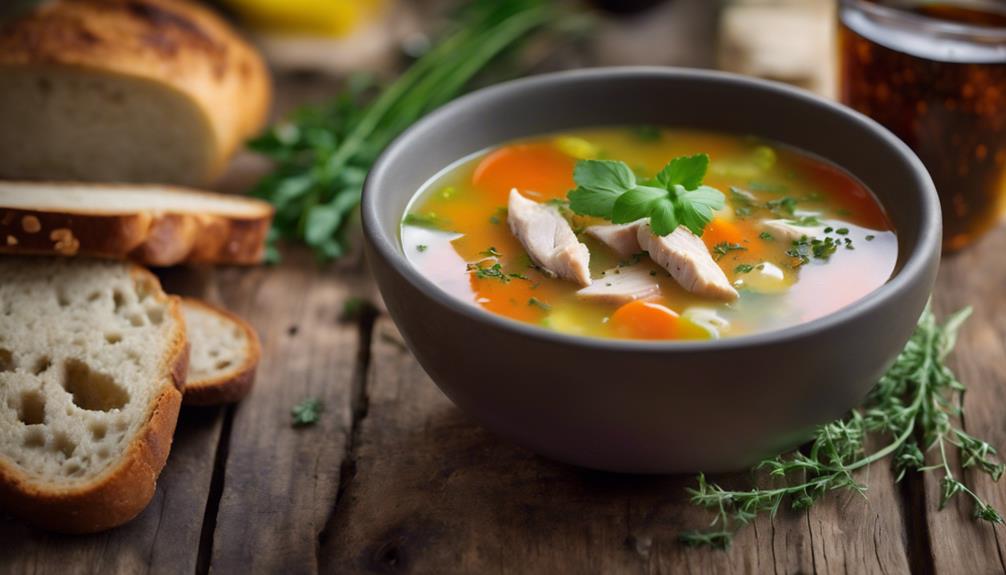
Looking for some new soup recipes to try at home? How about whipping up a batch of savory Chicken Noodle Soup, indulging in the creamy goodness of Potato Leek Soup, or warming up with a hearty Lentil Vegetable Soup?
These top soup recipes are sure to satisfy your cravings and impress your taste buds with their delicious flavors and comforting textures. Get ready to elevate your soup game with these classic and flavorful options!
Savory Chicken Noodle Soup
For a comforting and classic soup choice, try making a delicious batch of savory chicken noodle soup. This heartwarming dish is perfect for chilly days or whenever you need a bit of comfort.
Here are some tips to help you enjoy this flavorful soup:
- Start with a rich chicken broth: A good chicken broth forms the base of this soup, infusing it with savory flavors and nutrients.
- Add tender chicken pieces: Cooked chicken pieces bring protein and substance to the soup, making it a satisfying meal.
- Don't forget the noodles: Noodles not only add a comforting texture to the soup but also make it more filling and substantial.
Creamy Potato Leek Soup
To create a top-tier soup that's both velvety and flavorful, consider whipping up a batch of Creamy Potato Leek Soup. This soup offers a comforting blend of ingredients that result in a rich and satisfying dish perfect for a cozy evening or a gathering with friends.
Here are three tips to help you make the most of this creamy delight:
- Fresh Ingredients: Start by selecting fresh leeks, potatoes, and herbs to enhance the flavors of this soup. Using quality ingredients guarantees a tastier outcome.
- Blending Technique: Achieve that smooth and creamy texture by blending the cooked potatoes and leeks until they're velvety and free of lumps. This step is essential for a luxurious mouthfeel.
- Seasoning Savvy: Experiment with flavorful combinations of seasonings like thyme, garlic, and a pinch of nutmeg to elevate the taste profile of your Creamy Potato Leek Soup.
Hearty Lentil Vegetable Soup
Consider incorporating Hearty Lentil Vegetable Soup into your culinary repertoire for a nutritious and satisfying meal option. This soup offers a blend of hearty flavors and nutritious ingredients that will leave your taste buds and body feeling nourished.
When it comes to lentil cooking, this recipe excels in creating a rich and thick texture that's both comforting and filling. The vegetable pairing in this soup complements the lentils perfectly, adding a variety of flavors and textures to each spoonful.
To truly enjoy this Hearty Lentil Vegetable Soup, consider these tips:
- Experiment with different vegetable combinations to find your favorite mix.
- Allow the soup to simmer for an extended period to enhance the flavors.
- Consider adding a splash of lemon juice before serving for a rejuvenating twist.
Soup Preparation Techniques
When preparing your soup, consider employing various techniques to elevate its flavors.
Sous Vide Basics will help you achieve tender, juicy chicken and perfectly cooked vegetables.
Choosing the right vegetables and mastering flavor infusion methods can make a significant difference in the taste of your soup.
Sous Vide Basics
Enhance your soup preparation techniques by utilizing the precise and controlled method of sous vide cooking. Temperature control is essential in sous vide cooking as it guarantees that your ingredients are cooked to perfection without overcooking.
By vacuum sealing your chicken and vegetables before placing them in the sous vide water bath, you lock in flavors and juices, resulting in a more flavorful and tender soup.
Sous vide cooking involves sealing your ingredients in a plastic bag and cooking them in a water bath at a precise temperature for a specific amount of time. This method allows for even cooking throughout and retains the natural juices and flavors of the ingredients.
With sous vide cooking, you can achieve consistent results every time, making it an excellent technique for preparing soups like Chicken and Vegetable Soup. The controlled environment ensures that your soup ingredients are cooked to the exact doneness you desire, resulting in a delicious and nutritious meal for your family or guests.
Vegetable Selection Tips
Selecting the freshest vegetables plays a pivotal role in elevating the flavors of your homemade soup. When choosing seasonal vegetables, opt for a variety of colors and textures to create a visually appealing and tasty dish. Consider flavor combinations such as sweet carrots, earthy potatoes, and aromatic onions to enhance the overall taste of your soup. Maintaining the right ingredient ratios is vital; aim for a balance between vegetables, protein, and seasonings to achieve a harmonious blend of flavors.
To make sure that your vegetables retain their nutrients and flavors, it's important to cook them at the appropriate temperatures. Different vegetables require different cooking times, so be mindful of this when preparing your soup. Sous vide cooking provides a gentle and precise method for cooking vegetables, allowing them to maintain their texture and taste without getting mushy.
Flavor Infusion Methods
For ideal flavor infusion in your soup, explore various preparation techniques that can elevate the taste profile of your dish.
When considering flavor infusion methods, you can benefit from the precision and consistency of sous vide cooking. Sous vide benefits include the ability to seal in flavors and nutrients, resulting in a more intense taste experience. This method involves cooking ingredients in a vacuum-sealed bag at a controlled temperature for an extended period, allowing the flavors to meld perfectly.
Alternatively, traditional methods like slow cooking can also enhance the depth of flavors in your soup. Slow cooking allows the ingredients to simmer and release their essence gradually, resulting in a rich and robust taste.
On the other hand, if you're short on time, quick infusion methods like using aromatic herbs and spices can add layers of flavor rapidly. Experiment with different techniques to find the perfect balance of flavors that will delight your taste buds and those you serve.
Final Thoughts
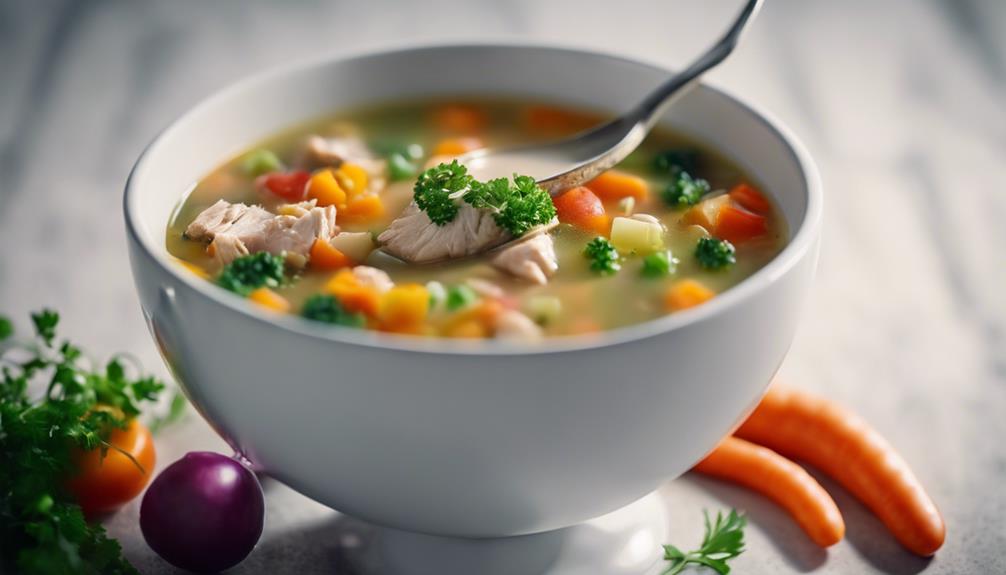
In conclusion, consider the overall flavors and textures of the Soup Sous Vide Chicken and Vegetable Soup as you reflect on your dining experience. This nutritious soup not only offers a delightful taste but also provides essential health benefits.
The tender chicken and fresh vegetables in this recipe make it a well-rounded meal choice for those following the 80/20 diet. For those looking to make modifications, consider adjusting the vegetable mix or experimenting with different herbs and spices to suit your preferences.
When it comes to storage tips and meal planning, remember that this soup can be easily stored in airtight containers in the refrigerator for a few days, allowing for convenient meal prep. Additionally, you can freeze portions for longer-term storage, perfect for busy days when you need a quick and nutritious meal option.
Incorporating this Soup Sous Vide Chicken and Vegetable Soup into your meal rotation can bring variety and balanced nutrition to your diet while being mindful of your health goals.
Frequently Asked Questions
Can I Freeze the Soup Sous Vide Chicken and Vegetable Soup?
Yes, you can freeze the soup. To maintain freshness, store it in airtight containers. When reheating, add extra seasoning for flavor. Meal prep by portioning into freezer-safe bags for easy grab-and-go meals.
How Long Can I Store the Soup in the Refrigerator?
To maintain freshness, proper storage is key. Your chicken and vegetable soup can stay refrigerated for up to 4 days. Remember to store it in a sealed container to preserve its flavors and quality.
Can I Substitute Chicken With Another Protein?
You can easily swap out chicken in the recipe for a tofu alternative or seafood. Tofu adds a vegetarian twist, while seafood brings a different flavor profile. Experiment to find the protein that suits your taste best!
What Are Some Common Soup Garnishes for This Recipe?
When serving soup, elevate it with garnish ideas like fresh herbs, croutons, or a drizzle of olive oil. Presentation tips include using colorful ingredients for visual appeal. Experiment with flavor profiles and ingredient variations for added creativity.
Are There Any Recommended Side Dishes to Pair With This Soup?
For soup pairings, consider fresh salads, whole grain bread, or roasted vegetables. These side dish options complement the soup perfectly and add variety to your meal planning. Achieve a nutritional balance by incorporating different food groups.
Conclusion
To sum up, soup-making has evolved over time to include a variety of key components that make for delicious and nutritious meals. By following simple preparation techniques and trying out top soup recipes, you can easily incorporate this healthy option into your diet.
Remember to focus on the 80/20 rule for balanced eating, and enjoy the benefits of homemade soup that's both satisfying and good for you. Happy cooking!
